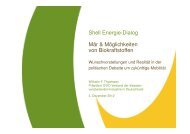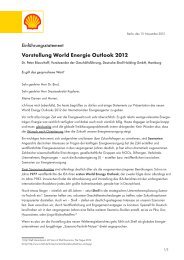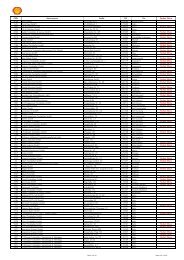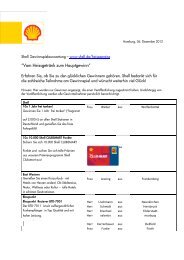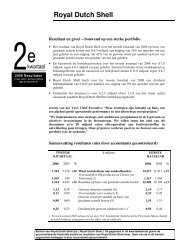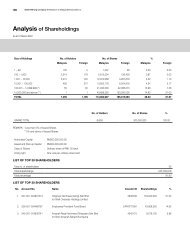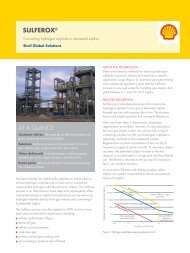ENVIRONMENTAL STATEMENT BARDOLINO DEVELOPMENT
ENVIRONMENTAL STATEMENT BARDOLINO DEVELOPMENT
ENVIRONMENTAL STATEMENT BARDOLINO DEVELOPMENT
You also want an ePaper? Increase the reach of your titles
YUMPU automatically turns print PDFs into web optimized ePapers that Google loves.
Bardolino Development Environmental Statement<br />
Total hydrocarbon concentrations (THCs) at sample stations more than 500 m from the<br />
Nelson platform station were found to be below the contaminant levels typically found in<br />
surface sediments in an offshore location in the North Sea (Table 4.7). Metal analysis<br />
indicated that heavy metal concentrations at the seabed sample locations more than 500 m<br />
from the Nelson platform were below the contaminant levels typically found in surface<br />
sediments in an offshore location of the North Sea.<br />
4.3 OFFSHORE CONSERVATION AREAS<br />
The European Community (EC) Directive 92/43/EEC on the Conservation of Natural Habitats<br />
and of Wild Flora and Fauna (the Habitats Directive), and the EC Directive 79/409/EEC on the<br />
Conservation of Wild Birds (the Birds Directive), are the main instruments of the European<br />
Union (EU) for safeguarding biodiversity.<br />
These Directives provide for the protection of animal and plant species of European<br />
importance and the habitats which support them, particularly through the establishment of a<br />
network of protected sites. The Habitats Directive includes a requirement to establish a<br />
European network of important high quality conservation sites that will make a significant<br />
contribution to conserving the habitat and species identified in Annexes I and II of the<br />
Directive. Habitat types and species listed in Annexes I and II are those considered to be in<br />
most need of conservation at a European level (JNCC, 2002, 2008).<br />
The UK government, with guidance from the Joint Nature Conservation Committee (JNCC)<br />
and the Department of Environment, Food and Rural Affairs (Defra), has statutory jurisdiction<br />
under the EC Habitats Directive to propose offshore areas or species (based on the habitat<br />
types and species identified in Annexes I and II) to be designated as Special Areas of<br />
Conservation (SAC). These designations have not yet been finalised, but will be made to<br />
ensure that the biodiversity of the area is maintained through conservation of important, rare<br />
or threatened species and habitats of certain species.<br />
Special Areas of Conservation (SACs) are sites that have been adopted by the European<br />
Commission and formally designated by the government of each country in whose territory<br />
the site lies. Sites of Community Importance (SCIs) are sites that have been adopted by the<br />
European Commission but not yet formally designated by the government of each country.<br />
Candidate SACs (cSACs) are sites that have been submitted to the European Commission,<br />
but not yet formally adopted. Candidate SACs will be considered in the same way as if they<br />
had already been classified or designated, and any activity likely to have a significant effect<br />
on a site must be appropriately assessed. Possible SACs (pSACs) are sites that have been<br />
formally advised to UK Government, but not yet submitted to the European Commission.<br />
Draft SACs (dSACs) are areas that have been formally advised to UK government as suitable<br />
for selection as SACs, but have not been formally approved by government as sites for public<br />
consultation (JNCC, 2008).<br />
In relation to UK offshore waters, four habitats from Annex I and four species from Annex II of<br />
the Habitats Directive are currently under consideration for the identification of SACs in UK<br />
offshore waters (JNCC, 2002, 2008; Table 4.8). Currently in UK offshore waters there are no<br />
SACs, cSACs or SCIs; there are seven possible SACs and one draft offshore site that have<br />
not yet been submitted to the European Commission (Table 4.9; JNCC, 2008).<br />
April 2008 Page 4-11




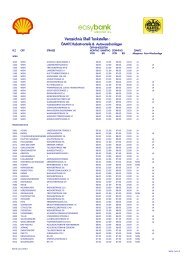
![Download Shell AutoGas Stationen [Stand: Januar 2013] (PDF](https://img.yumpu.com/9982753/1/190x245/download-shell-autogas-stationen-stand-januar-2013-pdf.jpg?quality=85)
